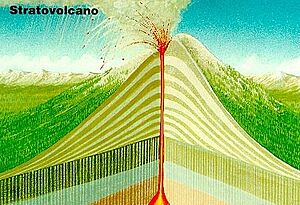Back River volcanic complex facts for kids
The Back River volcanic complex is a very old stratovolcano located in Northern Canada. It sits right on the border between the Northwest Territories and Nunavut. This ancient volcano is about 480 kilometers (300 miles) northwest of Yellowknife. It gets its name from the nearby Back River. This volcano is special because it hasn't been squished or changed much over time, unlike many other old rocks in the area. The southern part of the volcano is still standing upright, showing us what's left of its original shape. Scientists have found four main layers of rock here. These layers show how the volcano grew and changed over millions of years.
Contents
What is the Back River Volcano?
The Back River volcanic complex is a type of volcano called a stratovolcano. These volcanoes are usually cone-shaped and built up by many layers of hardened lava, ash, and rocks. They are known for their explosive eruptions. This particular volcano is also very, very old. It formed during a time called the Archaean Eon, which was billions of years ago.
How Old is the Back River Volcano?
Scientists use special methods to figure out the age of rocks. They found that the oldest parts of the Back River volcano formed about 2.7 billion years ago! That's a really long time ago, even before dinosaurs existed. The youngest parts formed around 2.58 billion years ago. This means the volcano was active for a very long time.
Layers of the Volcano
The Back River volcano is made of different layers, like a giant cake. Each layer tells a story about how the volcano grew and changed.
Innerring Layer
The Innerring layer is the oldest part of the volcano. It's like the very first foundation of the building. Scientists believe this layer is what's left of an early stage of the volcano, after some of it had worn away. It formed about 2.708 billion years ago.
Thlewyco Layer
The Thlewyco layer represents the main time when the volcano was actively growing. This layer is very thick, ranging from 2,500 to 5,000 meters (8,200 to 16,400 feet)! It's made of different kinds of lava and volcanic debris.
- On the north side, there are layers of andesitic and rhyolitic lava, followed by volcanic rocks.
- On the east side, there are many layers of andesitic lava flows.
- On the south side, there are layers of dacitic and andesitic lava, covered by thick layers of tuff (hardened volcanic ash) and other volcanic rocks.
This layer shows that the volcano had many explosive eruptions from different spots. The growth of this layer ended about 2.692 billion years ago with large eruptions of rhyolite and dacite lava.
Boucher-Regan Layer
The Boucher-Regan layer is mostly made of something called pillowed lava. This type of lava forms when hot lava erupts underwater and cools quickly, creating rounded, pillow-like shapes. This suggests that the northern side of the volcano was covered by water when this layer was forming.
Kelsh Layer
The Kelsh layer is found on the northwestern side of the volcano. It's made up of different kinds of broken rock pieces, including:
- Volcanic sand (volcarenite).
- Broken pieces of rhyolite and dacite from lava domes.
- Mixed rocks (polymict breccia).
- Conglomerate, which is a rock made of rounded pebbles and stones, including pieces of andesite and dacite-rhyolite.
- Andesitic tuff.
This layer also includes rocks like iron-formation, oolitic-stromatolitic carbonate (which might have formed with ancient life forms), and sulphidic volcanic rocks. These rocks mark the end of the volcano's active period. The Kelsh layer is thought to be a large fan of broken rock that formed underwater or near the surface, as the volcano slowly broke down. This layer formed about 2.586 billion years ago.
How Scientists Know the Age
The ages found for the Back River volcanic complex are similar to other very old volcanic rocks in the region. Scientists also study tiny crystals called zircons found in the rocks. These zircons act like tiny clocks, helping scientists figure out exactly when the rocks formed. This helps them understand the history of the Earth's crust in this area.


